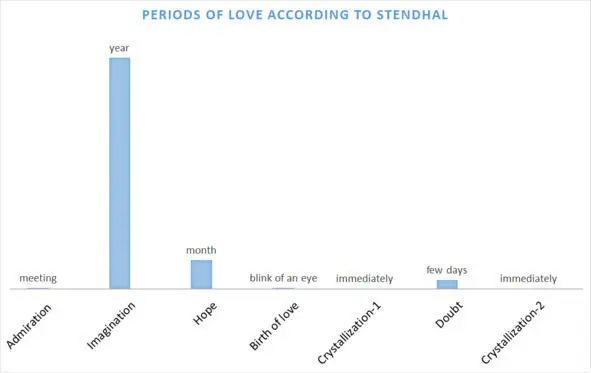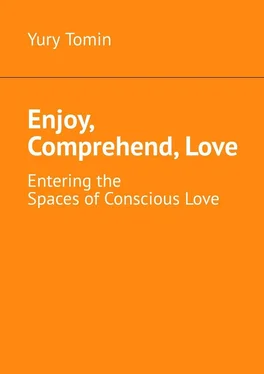A cold sweat covers me,
trembling seizes my body,
and I am greener than grass.
Lacking but little of death do I seem.
Sappho (half a century BC)
The soul is full of shame and fear
Dragged in dust and blood.
Cleanse my soul from dust
Deliver, oh God, from love!
Dmitry Merezhkovsky (early XX century)
Stendhal saw in love a complex interaction of the delight of passion, confusion of feelings, and torment of the mind, and also described the patterns of their crystallization into love. He was convinced that “every love that happens to be observed on earth is born, lives and dies or rises to immortality, following the same laws.”
How much meditation on Stendhal’s laws of love, as he hoped for it, can help in the healing of mental suffering – it is up to everyone to decide for himself. At least from a walk through the periods of love with Stendhal, one should take on a further journey for pondering the riddle of the second crystallization. At the same time, the question should not be simplified so as not to fall into the trap of Mephistopheles’ provocative casuistry:
You almost like a Frenchman prate;
Yet, pray, don’t take it as annoyance!
Why, all at once, exhaust the joyance?
Your bliss is by no means so great
As if you’d use, to get control,
All sorts of tender rigmarole,
And knead and shape her to you thought,
As in Italian tales ‘t is taught.
and, not realizing that behind the pause of an affair, there may be a preparation of the soul for love, like Faust, do not blurt out: “Without that, I have appetite.”
Doubts and the need for a second crystallization can suddenly arise out of nothingness repeatedly throughout the life of a lover.
On the very day of the wedding, a strange feeling came over Levin. “Fear and doubt found him, doubt in everything.” He rushes to the bride in order to receive firsthand the answer to his terrible doubts: “I think that you cannot love me. Why can you love me?” Levin is hardly considered a naive person, but, having received Kitty’s answer that “she loves him because she entirely understands him because she knows that he must love and that everything he loves is all right,” he calms down – “and it seemed to him quite clear.”
It is also quite clear that when Levin, walking through life, will open new horizons, change hobbies and acquire new meanings, he may again have questions: is he loved now and for what? Will he ask his wife again or will he read the answers in her eyes and gestures? Will Kitty, in other circumstances, be able to give him explicit or implicit assurances that “she understands him all,” or will this happy family become “unhappy in its own way,” as Leo Tolstoy shrewdly defined this possibility in the novel Anna Karenina ?
Concluding the consideration of Stendhal’s discoveries, it should be noted that, although he does not have a direct description of the transformation processes of the lover himself, it can be assumed that they are in one form or another implicit and present in a tacit form at all stages of love. It is unlikely that the process of crystallization that takes place between him and his beloved can be carried out in the consciousness of the unchanging Self of the lover, who is in his shell both before and after meeting with the object of love.
The first five periods of love according to Stendhal can be easily guessed in an elegant poem by Valery Bryusov:
We met with her by chance
And timidly I dreamed of her,
But long-cherished secret
Lurks in my sorrow.
But once in a golden moment
I have expressed my secret;
I saw a blush of confusion
I heard in response “I love.”
And the eyes flashed with trepidation,
And the lips merged into one.
Here is an old tale that
To be young is always destined.

Stages of the origin and crystallization of love
What the lyric hero of Vladimir Nabokov tragically foresees at the peak of being in love, sooner or later happens. Reality invades love. It, uninvited, unwelcomed, comes in a sad mask of resentment, evil robes of a quarrel, and the iron armor of jealousy. In addition, the gloomy gravitation of everyday problems constantly encroaches on the high feeling of love of the majority of citizens. For those who thought these trials were not enough, there is something in store ahead: life with a loved one will more than once remind you of the “cherished line” that cannot be crossed with “love and passion.”
Let’s get to know these enemies of love better. First, let’s throw off the mask from the resentment.
Sooner or later, the lover will inevitably have a feeling of resentment for one reason or another towards his partner. The fact is that resentment grows on the gap between our expectations of certain actions on the part of a partner and his real actions. The feeling of resentment is insidious, it ignores all objective criteria of the significance or insignificance of an act and can arise from a trifle. You can look at trifles with humor, saying to yourself: “Before marriage, I did not even suspect that it is possible to put milk in the refrigerator incorrectly.”
But you can make a gross mistake and mutter: “But what’s the difference.” At best, it can end up with a quick showdown, and at worst… Resentment, regardless of your love, will seep for reinforcement to completely uncontrollable levels of the psyche and suddenly burst out with a surge of irritation, anger, and rage. Some lovers quickly learn from their mistakes and try not to hide the resentment so that it does not grow stronger to explosive proportions, and more advanced ones begin to avoid it altogether, seriously taking up raising the level of their emotional intelligence.
Resentment signals, in particular, that your understanding of your partner (the element of intimacy) is insufficient. You have to admit that the first impression was superficial, and you are happy to find a lot of interesting and creative work to get to know your partner deeper.
The reason for the quarrel is usually more fundamental than that of the resentment. The quarrel may not have violent outbursts of anger, and it can drag on for a long time. This unpleasant reality of love relationships is well known to psychologists and studied within the framework of such a discipline as conflict management. A family conflict is a small war. And the battlefield is a clash of oppositely directed goals, interests, positions. We will take a closer look at conflicts in the chapter Curbing Conflicts , but for now we suggest that you independently reflect on five possible ways to resolve a love conflict: avoidance, domination, cooperation, adaptation, compromise, taking for example some real case in which one of your friends ended up. It should be remembered that any conflict has a positive solution, moreover, it mobilizes the resources of creativity for the development of relationships and revives passion.
The prevention of quarrels is connected, on the one hand, with mastering the skills of conflict resolution, and on the other, with the deepening of intimacy in such components as trust, respect, and awareness of common values.
Читать дальше













